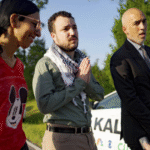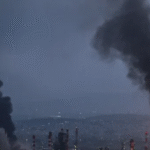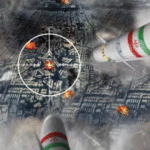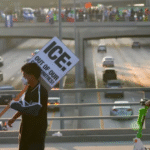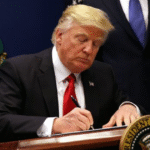Prosecutors in Montana have found a shocking wildlife trafficking ring. This group caused the death of at least 118 eagles. The main person, Branson Cuskic from Washington, made $150,000 to $280,000 from 2009 to 2021 by selling eagle parts illegally.
Cuskic didn’t just kill these birds. He “hacked them into pieces to sell for future profits.” The U.S. Attorney’s Office says Cuskic often took nine eagles at a time. This shows his actions were not just one-time mistakes.
Eagle parts, like wings and feathers, are important to Native Americans for ceremonies. But, U.S. laws strictly stop people from killing, hurting, or bothering eagles. They also don’t allow taking their nests or eggs without a special permit.
Key Takeaways
- Prosecutors have uncovered a wildlife trafficking ring responsible for the deaths of at least 118 eagles.
- The alleged ringleader, Branson Cuskic, made between $150,000 and $280,000 from 2009 to 2021 by illegally selling eagle parts.
- U.S. law prohibits the killing or disturbance of eagles without a permit, but Cuskic is accused of “hacking” the birds into pieces to sell.
- Eagle parts are in high demand for use in Native American ceremonies, but the illegal trade has had a devastating impact on eagle populations.
- Prosecutors are seeking significant imprisonment and restitution for Cuskic, underscoring the gravity of this wildlife crime.
The Shocking Details of a Wildlife Trafficking Ring
A recent investigation has uncovered a shocking wildlife trafficking ring. A man from Washington state made $150,000 to $280,000 over 12 years by selling eagle parts illegally. This is a disturbing case of cruelty for profit.
A Lucrative but Cruel Business
The trafficker’s actions were brutal. He caught up to nine eagles at once, then cut them into pieces to sell. These birds are highly valued by Native Americans for ceremonies, but killing them is illegal without a permit.
Prosecutors want the trafficker to face serious prison time and pay $699,000 in restitution. This is for the 118 eagles and 105 hawks he killed. The trafficker’s lawyer admits the trade was both profitable and cruel.
“This case highlights the shocking extent to which the illegal wildlife trade can devastate wildlife populations and the critical need for stronger enforcement and conservation efforts to protect our threatened wildlife and wild places.”
This trafficking ring shows us the need to fight wildlife crime. It threatens biodiversity and conservation of our wildlife and their habitats. We must work together to ensure wildlife and wild places survive. Cases like this highlight the importance of conservation efforts and working with conservation partners to protect and restore wildlife for the future.
A Gruesome Operation

This wildlife trafficking ring was shocking in its brutality and size. The leader, Branson, would kill protected eagles and cut them into pieces. He sold these parts for a profit.
Branson killed up to 9 eagles at once. He took their wings, tails, feathers, and other valuable parts. These were sold to Native Americans for ceremonies on the black market.
This crime harmed eagle populations and ignored the need to protect endangered species. The illegal wildlife trade is a big problem worldwide. WWF and others are fighting hard to stop it and protect wildlife.
“The scale and cruelty of this poaching operation is truly shocking. These criminals showed a complete disregard for the lives of these protected eagles, treating them as nothing more than a commodity to be exploited for profit.”
We need to strengthen conservation efforts and enforce wildlife laws to stop the illegal wildlife trade. Working together, we can help wildlife and their homes. This will benefit both people and nature.
Prosecuting the Wildlife Trafficker

Prosecutors in a big wildlife trafficking case want Branson to face serious consequences. They say he made $150,000-$280,000 over 12 years by selling eagle and hawk parts illegally. They ask the judge to give him a long jail sentence and make him pay over $699,000. This includes $5,000 for each of the 118 eagles and $1,470 for each of the 105 hawks he killed.
Disputed Claims and Public Outcry
But, the case has faced controversy. Branson’s lawyers argue the evidence is not strong enough and their client shouldn’t be blamed for all the alleged crimes. This has started a public debate. People who care about wildlife and conservation want the court to make a strong statement against illegal wildlife trade.
“This case is about more than just one individual’s actions – it’s about sending a clear signal that wildlife trafficking will not be tolerated,” said a spokesperson for a leading wildlife conservation organization.
The trial’s outcome is being watched closely by everyone. People hope justice will be done and this case will help stop the illegal wildlife trade. They also hope it will protect endangered species and their wildlife habitats.
The Illegal Wildlife Trade and Eagles

The illegal wildlife trade is a big threat to many species, including the majestic eagle. These birds are often targeted by traffickers who want to make money from their parts and feathers. The report shows that a group of traffickers killed at least 118 eagles over 12 years.
In the U.S., it’s illegal to harm eagles or take their nests or eggs without a permit. But, the demand for eagle parts, especially by Native American communities for ceremonies, fuels a black market. This has led to the killing of many eagles, which could harm their populations and conservation efforts.
This case shows how important it is to stop the illegal wildlife trade and protect eagles. Groups like WWF are working hard to spread awareness, improve enforcement, and find sustainable ways to protect these birds and their homes.
“The illegal wildlife trade is a global crisis that threatens the very existence of many species, including the iconic eagle. It is our collective responsibility to take action and ensure these magnificent creatures can thrive in the wild for generations to come.”
Protecting wildlife and their homes is crucial. The eagle traffickers’ case reminds us of the harm caused by illegal wildlife trade. By working together, we can stop these criminals, support conservation, and help the world’s wildlife and wild places.
| Species | Estimated Population | Threat Level | Conservation Status |
|---|---|---|---|
| Bald Eagle | 333,000 | Least Concern | Recovered |
| Golden Eagle | 40,000-50,000 | Least Concern | Stable |
| Harpy Eagle | 50,000 | Near Threatened | Vulnerable |
Wildlife Trafficking: A Global Crisis

The illegal wildlife trade is a major issue today. It involves the capture, trade, and killing of wild animals for money. In the Americas, this has hurt many species, putting their survival at risk.
The World Wildlife Fund (WWF) says wildlife trafficking is the fourth-largest illegal trade, worth about $20 billion a year. This trade hurts vulnerable wild populations, leading to the decline of many endangered species. No animal is safe from those who want to exploit them.
This problem affects humans too. It can spread diseases like COVID-19 to people. It also funds illegal activities, like organized crime and terrorism.
The WWF and other groups are fighting this issue. They aim to protect wildlife habitats, support anti-poaching efforts, and stop the illegal wildlife trade. They work with governments, communities, and partners worldwide to ensure wildlife and wild places can survive.
| Wildlife Species | Conservation Status | Threats from Illegal Trade |
|---|---|---|
| African Elephant | Vulnerable | Poaching for ivory |
| Pangolin | Critically Endangered | Hunting for scales and meat |
| Tiger | Endangered | Poaching for traditional medicine and trophies |
| Rhinoceros | Critically Endangered | Poaching for horn |
Stopping wildlife trafficking is hard but urgent. We need to spread awareness, support conservation, and act against the illegal trade. Together, we can protect our planet’s biodiversity for the future.
“Wildlife trafficking is a global crisis that requires a coordinated, international response. We must work together to put an end to this devastating trade and protect the natural world for all.”
– John Scanlon, former Secretary-General of the Convention on International Trade in Endangered Species of Wild Fauna and Flora (CITES)
Combating Wildlife Crime

The global wildlife trafficking crisis is getting worse. We need strong conservation efforts now more than ever. Organizations and people around the world are fighting hard to save endangered species and protect their homes. The World Wide Fund for Nature (WWF) is leading this fight.
WWF uses many strategies to protect wildlife. They work on law enforcement, breaking up trafficking networks, and helping local communities. With governments, agencies, and partners, WWF aims to ensure wildlife and their habitats are safeguarded for generations to come.
Strengthening Law Enforcement
WWF is focusing on making law enforcement stronger. They give training and resources to wildlife rangers. This helps them catch poachers and protect areas.
WWF also pushes for harsher penalties for wildlife traffickers. This shows that such crimes won’t be ignored.
Disrupting Trafficking Networks
WWF is determined to break down wildlife trafficking networks. They gather information, track illegal trade, and work with border authorities. This helps disrupt the supply chain and cut off the flow of illegal wildlife products.
Engaging Local Communities
WWF knows that protecting wildlife is linked to local communities’ well-being. They support sustainable jobs, eco-tourism, and empower communities. This makes people feel connected to conservation efforts.
The illegal wildlife trade has big problems for our world. But, groups like WWF are showing us hope. With teamwork and new ideas, we can work towards a future where wildlife and wild places thrive, to the benefit of both people and nature.
Also Read : September Kicks Off With Potentially Record-Breaking Heat In The Southwest And Along The West Coast.
Conclusion
The case in Washington State shows how bad the illegal wildlife trade can be. It killed at least 118 eagles over 12 years. This shows how big and cruel this problem is.
We need to protect our planet’s wildlife more. This means we must work hard to stop the illegal wildlife trade. We need to join forces with groups, communities, and partners worldwide to save endangered animals.
Our planet’s future depends on us protecting wildlife and their homes. Let’s speak up for those who can’t. By acting together, we can keep our natural world safe. Protecting wildlife means we’re working for a better future for everyone and the earth.
FAQs
Q: What steps are being taken to protect wildlife in light of the recent wildlife trafficking ring?
A: In response to the wildlife trafficking ring responsible for the deaths of at least 118 eagles, conservation organizations like WWF are increasing efforts to enforce laws against the international wildlife trade and promote conservation news to raise awareness. They aim to protect wildlife by implementing stricter regulations and collaborating with local communities to conserve habitats.
Q: How does wildlife trafficking impact endangered species?
A: Wildlife trafficking poses a significant threat to endangered species, leading to habitat loss and extinction. The illegal trade of animal species disrupts ecosystems and diminishes biodiversity, making it crucial to ensure wildlife conservation efforts are prioritized to protect these living things.
Q: What role do international organizations play in combating wildlife trafficking?
A: Organizations such as WWF play a vital role in combating wildlife trafficking by advocating for policies that protect wildlife and wild places, conducting research on threatened wildlife, and collaborating with governments to enforce conservation laws. Their voice for wildlife is essential in raising awareness and promoting sustainable practices.
Q: How can individuals contribute to wildlife conservation efforts?
A: Individuals can contribute to wildlife conservation by supporting organizations that focus on conserving fauna and flora, reducing their ecological footprint, and advocating for policies that protect natural habitats. Engaging in local conservation projects and educating others about the importance of protecting wildlife and wild places can make a significant impact.
Q: What are some examples of human activities that contribute to habitat loss?
A: Human activities such as deforestation, urban development, and pollution are major contributors to habitat loss. These actions threaten the survival of many wildlife species as they disrupt their natural environments and decrease available resources needed for survival.
Q: Why is it important to connect with other members of the conservation community?
A: Connecting with other members of the conservation community is important for sharing knowledge, resources, and support. Collaborative efforts can lead to more effective conservation strategies and greater impact in protecting wildlife across North America and worldwide.
Q: What are the long-term goals for wildlife conservation by 2030?
A: The long-term goals for wildlife conservation by 2030 include achieving a significant reduction in poaching and wildlife trafficking, restoring habitats, and ensuring that wildlife thrive in their natural environments. These goals aim to secure a future for people and nature by balancing ecological needs with human development.
Q: How does habitat loss affect both wildlife and human populations?
A: Habitat loss adversely affects wildlife by reducing their living spaces and resources, often leading to population declines. For human populations, it can disrupt ecosystems that provide essential services such as clean air, water, and food sources, highlighting the interconnectedness of people and wildlife.
Q: What initiatives are in place to monitor and report on wildlife trafficking?
A: Initiatives such as the Living Planet Report and various conservation news outlets regularly monitor wildlife trafficking and report on its impact on global biodiversity. These initiatives help raise awareness and support policy changes aimed at protecting threatened wildlife and ensuring sustainable practices.
Source Links
- https://www.leadertelegram.com/news/nation-world/wildlife-trafficking-ring-killed-at-least-118-eagles-prosecutors-say/article_dc387c55-5a71-5b98-8594-9850339dd31b.html
- https://repository.law.miami.edu/cgi/viewcontent.cgi?article=2677&context=umialr
- https://www.frontiersin.org/journals/conservation-science/articles/10.3389/fcosc.2024.1400613/full
